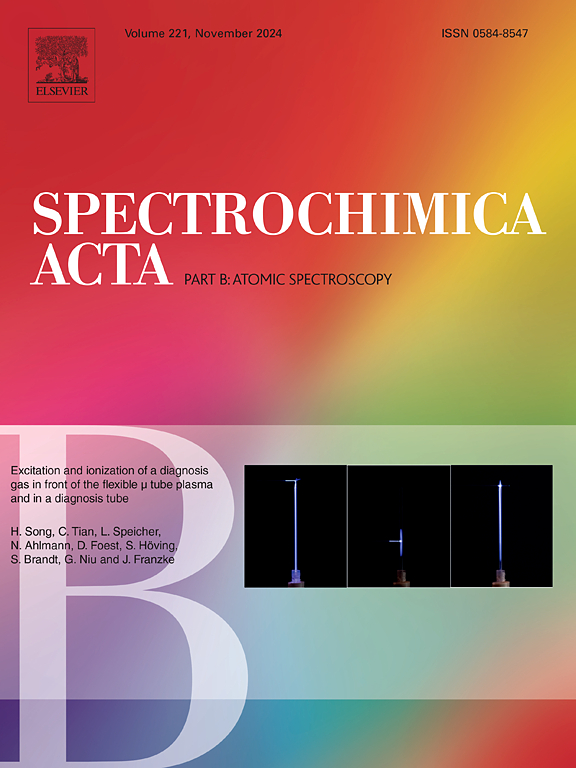Study of the discharge mode transition in a Ne-flexible micro-tube plasma (FμTP)
IF 3.8
2区 化学
Q1 SPECTROSCOPY
引用次数: 0
Abstract
Not only Helium and Argon but also Neon, Krypton, and Xenon can be used as plasma gas for a discharge applied for soft ionization with similar ionization efficiency, although it is clear that each of the excited and even ionized states of Xe is lower than the ion energy of N2+ or H3O+. In this work, the discharge behavior of these plasmas both inside and outside of the capillary was investigated to study the mechanisms of soft ionization. Two discharge modes were found. In He- and Ne2.0 kV -FμTP, the ionization wave of N2+ is mainly responsible for the propagation of excitation and ionization inside the capillary while the ionization wave of noble gas ions plays the role in Ar-, Kr- and Xe-FμTP. With an increase of the applied voltage, Ne2.5 kV -FμTP fulfils characteristics of both categories. All the measured ionization waves stop in the vicinity of the capillary outlet. For all plasmas, the propagation of excitation wave is tracked in ambient surrounding, which hints that an ionization wave is propagating outside the capillary. It is assumed that ions species of air components such as N2+, O2+ and H3O+ are generated in the ambient surrounding. The ionization wave of these ions continues supporting the propagation of the excitation wave.

ne柔性微管等离子体(FμTP)放电模式跃迁的研究
不仅氦气和氩气,氖气、氪气和氙气也可用作软电离放电的等离子气体,并具有类似的电离效率,但很明显,氙气的每个激发态甚至电离态都低于 N2+ 或 H3O+ 的离子能量。本研究调查了这些等离子体在毛细管内外的放电行为,以研究软电离的机制。研究发现了两种放电模式。在 He- 和 Ne2.0 kV -FμTP 中,N2+ 的电离波主要负责毛细管内激发和电离的传播,而在 Ar-、Kr- 和 Xe-FμTP 中,惰性气体离子的电离波起作用。随着外加电压的增加,Ne2.5 kV -FμTP符合这两种类型的特征。所有测得的电离波均在毛细管出口附近停止。在所有等离子体中,激发波的传播都是在周围环境中进行的,这表明电离波是在毛细管外传播的。假设周围环境中产生了 N2+、O2+ 和 H3O+ 等空气成分的离子。这些离子的电离波继续支持激波的传播。
本文章由计算机程序翻译,如有差异,请以英文原文为准。
求助全文
约1分钟内获得全文
求助全文
来源期刊
CiteScore
6.10
自引率
12.10%
发文量
173
审稿时长
81 days
期刊介绍:
Spectrochimica Acta Part B: Atomic Spectroscopy, is intended for the rapid publication of both original work and reviews in the following fields:
Atomic Emission (AES), Atomic Absorption (AAS) and Atomic Fluorescence (AFS) spectroscopy;
Mass Spectrometry (MS) for inorganic analysis covering Spark Source (SS-MS), Inductively Coupled Plasma (ICP-MS), Glow Discharge (GD-MS), and Secondary Ion Mass Spectrometry (SIMS).
Laser induced atomic spectroscopy for inorganic analysis, including non-linear optical laser spectroscopy, covering Laser Enhanced Ionization (LEI), Laser Induced Fluorescence (LIF), Resonance Ionization Spectroscopy (RIS) and Resonance Ionization Mass Spectrometry (RIMS); Laser Induced Breakdown Spectroscopy (LIBS); Cavity Ringdown Spectroscopy (CRDS), Laser Ablation Inductively Coupled Plasma Atomic Emission Spectroscopy (LA-ICP-AES) and Laser Ablation Inductively Coupled Plasma Mass Spectrometry (LA-ICP-MS).
X-ray spectrometry, X-ray Optics and Microanalysis, including X-ray fluorescence spectrometry (XRF) and related techniques, in particular Total-reflection X-ray Fluorescence Spectrometry (TXRF), and Synchrotron Radiation-excited Total reflection XRF (SR-TXRF).
Manuscripts dealing with (i) fundamentals, (ii) methodology development, (iii)instrumentation, and (iv) applications, can be submitted for publication.

 求助内容:
求助内容: 应助结果提醒方式:
应助结果提醒方式:


